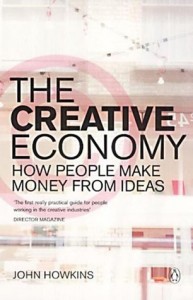 With this post, PublishingTrends.com continues its regular column in which it reviews, explicates and excerpts books that we think will resonate with people in the business of publishing and media.
With this post, PublishingTrends.com continues its regular column in which it reviews, explicates and excerpts books that we think will resonate with people in the business of publishing and media.
****
With lots of comments lately about books being defined more in terms of “content” in the face of new digital media, the role of creativity in the publishing industry has become increasingly important for both creating content for products and inventing new types of products. In John Howkins’ updated edition of his well known book, The Creative Economy (Penguin, 2007), Howkins, who recently gave the opening keynote at OnCopyright 2012, discusses the dynamics and shifts in the creative economy over the past decades and the effects that digital innovation will have on creative goods in the future. Through his evaluation of current industry, as well as how the value of the author has evolved over time, Howkins presents challenges that current copyright laws pose on ever-changing creative products, with books, music, and films being particular areas of focus.
In the book, Howkins evaluates the current conundrum of the creative economy:
Two trends are interwoven. Creative people and organizations are becoming more businesslike; and business is becoming more dependent upon creativity. Both produce more copyrights and register more patents, and often push for privatization of what was public.
Much of what Howkins traces throughout his book is the idea of “intellectual property” and the movement from the tangible to the intangible. Should people be able to control creative output as concretely as physical property? Howkins explores responses to this question through people from Andrew Wylie (who believes authors should own their works) and Disney (who has more ownership/control over their properties through the trademarking of their company) to fifteenth-century European society (which believed that artists’ work belonged to the community) and Grateful Dead lyricist John Perry Barlow (who believes relationships will be more powerful than possession in the digital future). Howkins argues that perspectives will inevitably need to shift, however, in the face of digital innovation. He describes the creative market as moving away from necessarily dealing in terms of goods and more as services – that we are moving from a society of buying to one of renting. As he quotes Release 2.0 author Esther Dyson, “The likely best defence for content providers is to distribute intellectual property free in order to sell services and relationship.” In the book, this idea is exemplified by Gillette selling its razors for well below cost while charging high prices for its blades, but an obvious comparison can also be drawn to ereading devices and the ecosystems through which ereader users purchase their books.
Inevitably, Howkins also turns his attention to DRM as an enforcer of copyright, highlighting the importance of software, watermarks, and even digital detective agencies in tracking infringers and staving off pirates. Howkins outlines the current predicament creative industries face with copyright law:
Copyright material is best protected by two factors: a mixture of good law and bad technology. By good law, I mean law that is fair and effective, and whose remedies are proportionate to the mischief. By bad technology, I mean technology’s inability to make good copies. The best protection is a legal copy that is cheaper or more easily available than the illegal one. The challenge of digital is the technology for creating and copying (or recreating) material is now cheaply and widely available and the users and consumers are minded to take what they can. That puts more pressure on the laws, which are not certain of coping. The technology is leading the race, with the users close behind, and the laws a distant third.
One of the biggest copyright weaknesses Howkins focuses on is its fluidity in contrast to a more stringent protector of intellectual property like the patent, which has a defined application process and gives clearer, more-inclusive ownership over a particular invention. “Fair use” and “public use” especially make it hard to identify what is copying and what is not. As a result, because copyright is harder to define and enforce, it becomes a challenge for companies to offer incentives and business models that will protect creative output without relying on the law.
Through an understanding of how digital is uprooting traditional understandings of intellectual property, Howkins outlines the challenges that publishers and other arts industries face as they try to prosper in the creative economy. With goods becoming increasingly intangible, it is up to businesses to establish the market value of ideas and how they are exchanged. As Howkins points out himself, “Industries do not collapse because their existing business models are threatened but because they fail to find new ones.”






